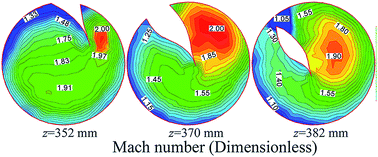The swirling flow structure in supersonic separators for natural gas dehydration
Abstract
The supersonic separator is a novel compact tubular device for natural gas dehydration. The separation mechanism is not well understood for the complicated fluids with a delta wing located in the supersonic flows. We investigated the gas swirling separation characteristics in supersonic velocities using the Reynolds stress turbulence model. The results showed that the Laval nozzle designed with the cubic polynomial and Foelsch's analytical methods formed an extremely stable and uniform supersonic flow. The delta wing generated a strong swirling flow with the centrifugal acceleration of around 107 m s−2 to remove the condensed liquids from the mixture. However, the supersonic flow was quite sensitive to the delta wing, which led to the disturbance and non-uniformity of the gas dynamic parameters. This violent variation in the supersonic flow had a secondary action on the condensation, even resulting in the re-evaporation of the condensed liquids.


 Please wait while we load your content...
Please wait while we load your content...